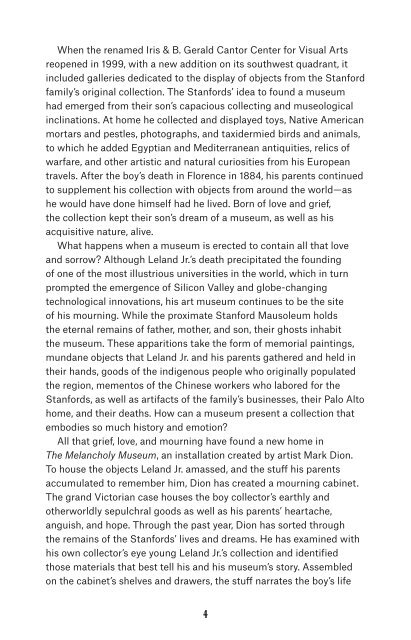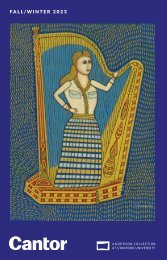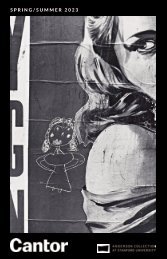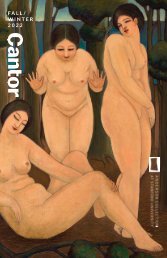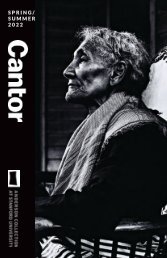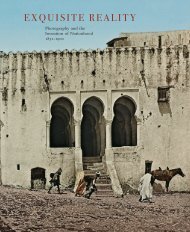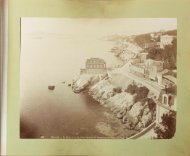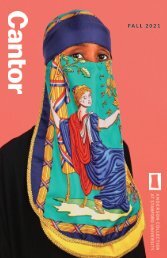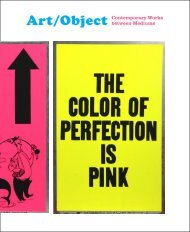Gallery Guide | The Melancholy Museum
Using over 700 items from the Stanford Family Collections, artist Mark Dion’s exhibition "The Melancholy Museum" explores how Leland Stanford Jr.’s death at age 15 led to the creation of a museum, university, and—by extension—the entire Silicon Valley.
Using over 700 items from the Stanford Family Collections, artist Mark Dion’s exhibition "The Melancholy Museum" explores how Leland Stanford Jr.’s death at age 15 led to the creation of a museum, university, and—by extension—the entire Silicon Valley.
You also want an ePaper? Increase the reach of your titles
YUMPU automatically turns print PDFs into web optimized ePapers that Google loves.
When the renamed Iris & B. Gerald Cantor Center for Visual Arts<br />
reopened in 1999, with a new addition on its southwest quadrant, it<br />
included galleries dedicated to the display of objects from the Stanford<br />
family’s original collection. <strong>The</strong> Stanfords’ idea to found a museum<br />
had emerged from their son’s capacious collecting and museological<br />
inclinations. At home he collected and displayed toys, Native American<br />
mortars and pestles, photographs, and taxidermied birds and animals,<br />
to which he added Egyptian and Mediterranean antiquities, relics of<br />
warfare, and other artistic and natural curiosities from his European<br />
travels. After the boy’s death in Florence in 1884, his parents continued<br />
to supplement his collection with objects from around the world—as<br />
he would have done himself had he lived. Born of love and grief,<br />
the collection kept their son’s dream of a museum, as well as his<br />
acquisitive nature, alive.<br />
What happens when a museum is erected to contain all that love<br />
and sorrow? Although Leland Jr.’s death precipitated the founding<br />
of one of the most illustrious universities in the world, which in turn<br />
prompted the emergence of Silicon Valley and globe-changing<br />
technological innovations, his art museum continues to be the site<br />
of his mourning. While the proximate Stanford Mausoleum holds<br />
the eternal remains of father, mother, and son, their ghosts inhabit<br />
the museum. <strong>The</strong>se apparitions take the form of memorial paintings,<br />
mundane objects that Leland Jr. and his parents gathered and held in<br />
their hands, goods of the indigenous people who originally populated<br />
the region, mementos of the Chinese workers who labored for the<br />
Stanfords, as well as artifacts of the family’s businesses, their Palo Alto<br />
home, and their deaths. How can a museum present a collection that<br />
embodies so much history and emotion?<br />
All that grief, love, and mourning have found a new home in<br />
<strong>The</strong> <strong>Melancholy</strong> <strong>Museum</strong>, an installation created by artist Mark Dion.<br />
To house the objects Leland Jr. amassed, and the stuff his parents<br />
accumulated to remember him, Dion has created a mourning cabinet.<br />
<strong>The</strong> grand Victorian case houses the boy collector’s earthly and<br />
otherworldly sepulchral goods as well as his parents’ heartache,<br />
anguish, and hope. Through the past year, Dion has sorted through<br />
the remains of the Stanfords’ lives and dreams. He has examined with<br />
his own collector’s eye young Leland Jr.’s collection and identified<br />
those materials that best tell his and his museum’s story. Assembled<br />
on the cabinet’s shelves and drawers, the stuff narrates the boy’s life<br />
and death through<br />
images and objects<br />
related to the four<br />
elements—earth, air,<br />
fire, and water—and<br />
ether, his final resting<br />
place. Individually<br />
and collectively these<br />
aggregated materials<br />
give Leland Jr. and his<br />
parents an afterlife<br />
within the museum.<br />
Dion also has<br />
excavated other<br />
Stanford histories,<br />
of both family and<br />
place. Digging through<br />
Special Collections<br />
Émile Munier (1840–1895), Leland Stanford Jr. and the Archaeology<br />
as an Angel Comforting His Grieving Mother,<br />
Center, he found<br />
1884. Cantor Arts Center<br />
assorted letters,<br />
ledgers, and objects<br />
to describe the lives and deaths of others whose lives and labor made<br />
possible the university and the museum and its collections. <strong>The</strong>se<br />
causalities and tragedies are also represented in <strong>The</strong> <strong>Melancholy</strong><br />
<strong>Museum</strong> in the form of fragmented pots, tools, and bodies.<br />
Through objects alone, Dion’s installation tells the story of how<br />
one family’s rush West to sell hardware to prospectors resulted in the<br />
accumulation of vast wealth and power. <strong>The</strong> furniture, photographs,<br />
Native American objects, menus, and other artifacts of material life at<br />
the turn of the twentieth century that comprise the artwork show how<br />
the family upgraded its business interests to politics, the railroad, and<br />
a horse farm, and how those interests were enabled by land previously<br />
inhabited by the Ohlone people and the labor of Chinese and other<br />
immigrants. Finally, the grand Victorian mourning cabinet, the heart<br />
of Dion’s work, demonstrates how one teenage boy’s death resulted<br />
not in the creation of the nation’s largest museum but in a museum<br />
where love, grief, and mourning are forever entwined, <strong>The</strong> <strong>Melancholy</strong><br />
<strong>Museum</strong>.<br />
4<br />
5


